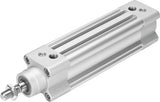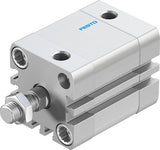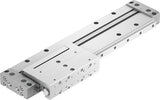ISO 6432 Pneumatic Cylinders

Figure 1: ISO 6432 pneumatic cylinder
Pneumatic cylinders that conform to the ISO 6432 standard produce linear motion using compressed air. These cylinders feature a small and round profile that remains consistent among various manufacturers and is ideal for compact and precise applications. ISO 6432 pneumatic cylinders can be considered "mini pneumatic cylinders" because they typically have a smaller bore diameter (8-25 mm). This article describes the importance of ISO standards, the value of using ISO 6432 pneumatic cylinders, and the basic characteristics of these pneumatic cylinders.
View our online selection of pneumatic cylinders!
The purpose of ISO standards
The International Organization for Standardization (ISO) offers a universally acknowledged framework to guarantee that products, services, and systems conform to superior standards for quality, safety, and performance. Developed by experts from diverse fields through a collaborative process, these standards provide a methodical and organized approach to design, production, and delivery that minimizes the possibility of errors, failures, and deviations.
Pneumatic cylinder operation principle
Pneumatic cylinders come in two types: single-acting and double-acting. Single-acting cylinders operate by having compressed air enter the pneumatic port, pushing the piston in a single direction. When the supply of compressed air stops, a compressed spring returns the piston to its original position. Double-acting pneumatic cylinders have a pneumatic port on both sides of the cylinder. Compressed air moves the piston in both directions, providing better control over its position. Read our pneumatic cylinder overview article to learn more.
ISO 6432 pneumatic cylinders
ISO 6432 defines the dimensions and specifications for the design and manufacture of pneumatic cylinders with bore sizes ranging from 8 mm to 25 mm, and with maximum working pressure levels of up to 10 bar. ISO 6432 pneumatic cylinders have the following advantages:
- Interchangeability: An ISO 6432 pneumatic cylinder in a system can be replaced with any cylinder brand conforming to the ISO 6432 standard. This allows users to choose a pneumatic cylinder based on cost and availability.
- Design: ISO 6432 pneumatic cylinders have a round and compact design that allows them to be used in compact spaces.
- Material: ISO 6432 pneumatic cylinders are produced in various materials to suit different applications. While aluminum cylinders are widely used, stainless steel cylinders are also available for applications that demand high resistance to corrosion, particularly in hygienic environments.
Characteristics
ISO 6432 pneumatic cylinders have the following characteristics:
- Max pressure: 10 bar (145 psi)
- Piston bore sizes: 8 mm, 10 mm, 12 mm, 16 mm, 20 mm, and 25 mm
- Nominal stroke length: The nominal stroke length for ISO 6432 is derived from the ISO 4393 standard. The maximum stroke length is 2000 mm.
- Direction of movement: Single- and double-acting
- Cushioning:Cushioning in a pneumatic cylinder decelerates the piston. ISO 6432 only applies to cylinders with mechanical cushioning. However, manufacturers create pneumatic cylinders that adhere to all other ISO 6432 standards but have pneumatically adjustable cushioning or self-adjusting cushioning.
For a complete understanding of these pneumatic cylinders, refer to the ISO 6432 standard, which gives complete information on the following:
- Dimensions
- Nominal stroke
- Bore sizes
- Mounting types
- Piston rod characteristics
Larger bore diameters
Round pneumatic cylinders can have larger diameters but the ISO 6432 standard does not cover them. Round pneumatic cylinders can have bore sizes that go up to 100 mm. These cylinders provide high force output and reliability in heavy-duty industrial applications. These cylinders may feature advanced technologies such as magnetically coupled sensors, adjustable cushioning, and non-contact position sensing, all of which help to improve precision and control. These cylinders can be single-acting or double-acting, and may utilize a variety of mounting options, including flange, foot, or trunnion mounting.
Read our ISO 15552 pneumatic cylinders article for more details on the characteristics of these cylinders.











